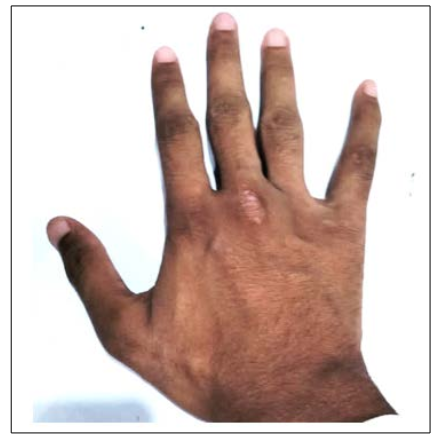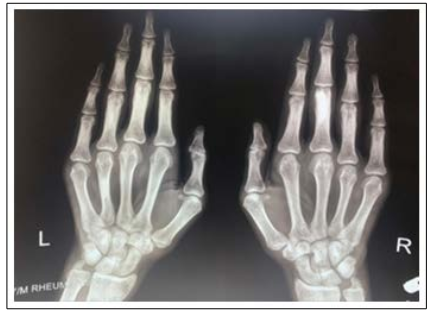Author(s): Asif Islam, Fatima Khurshid,* Fatema Ali Asghar
Rhupus syndrome is an uncommon and difficult clinical disease that results from the co-occurrence of Rheumatoid Arthritis (RA) and Systemic Lupus Erythematosus (SLE). There is an underdiagnosis of rhupus cases because the overlapping symptoms of both conditions frequently do not match the standard diagnostic criteria for autoimmune disorders. The neurological and physiological difficulties linked to this complex illness have a substantial impact on the health-related quality of life of patients. Pain, swelling, stiffness, deformities, and varied degrees of functional impairment are among the signs that must be identified in order to diagnose rhupus clinically. The clinical information of a young male exhibiting rheumatoid arthritis symptoms is presented in this case report. For a proper diagnosis and efficient treatment, it is essential to comprehend and deal with the complexity of rheumatoid arthritis.
The term Rhupus was coined in the year 1971 referring to this condition. The prevalence of Rhupus syndrome has been estimated to be around 0.01% to 2% of patients with rheumatic diseases [1,2]. It has been defined as a deforming and erosive symmetric polyarthritis accompanied by symptoms of SLE and the presence of antibodies such as anti-dsDNA, anti-Smith, and Rheumatoid Factor (RF), with or without anti-Cyclic Citrullinated Peptides (anti-CCP) antibody [3]. When diagnosing systemic autoimmune illnesses, up to 25% of patients are misdiagnosed. Multiple rheumatic diseases in one individual, such as Rhupus syndrome, which combines RA and SLE, provide difficult issues. The typical SLE-related manifestations tend to be mild and predominantly involve issues with blood, as well as affecting the skin, serous membranes, and the kidneys. However, Rhupus arthritis generally follows a pattern resembling that of Rheumatoid Arthritis (RA), and it can advance to include typical inflammatory erosions, deformities, and resulting disability [4]. Earlier reports have indicated that Rhupus patients typically display more pronounced clinical manifestations associated with RA, with relatively mild organic damage related to SLE. The prognosis for individuals with Rhupus syndrome is contingent on the extent of internal organ damage, falling between that of SLE and RA, leaning more towards RA-related damage. While SLE displays frequent kidney damage. The disease’s duration tends to be longer than the typical course of RA or SLE [5]. We present the case of a 20-year-old male who presents with joint pain and swelling, highlighting the diagnostic problems associated with Rhupus syndrome, a rare overlap disease between RA and SLE.
A 22-year-old male patient was admitted to the hospital with complaints of hair loss, and joint pain. According to his medical history, pain and swelling in his knees, heel, and fingers (Figure 01), and especially morning stiffness in his knee, had started 3 years before he was admitted to the hospital.
There were different areas of hair loss in occipital region. There was tenderness in both knees and foot joints, and particularly in the heels, according to his joint examination. Cardiovascular, respiratory, and gastrointestinal examinations were normal. Whole blood glucose, serum urea and creatinine levels, liver function tests (ALT, AST) were normal. There was no fecal occult blood. Sedimentation was 120 (normal 0 to 20), C-reactive protein was 24 (normal 0 to 6), Rheumatoid factor 889.60 IU/mL (normal range <14), cyclic citrullinated peptide antibody (anti-CCP) >200 U/mL (normal < 4), antinuclear antibody (ANA) + at dilution of 1:5120 with homogenous pattern, anti-dsDNA antibody (+++positive), antiSmith antibody (++positive), anti SS-A/Ro (60kD) (++positive), complement 3 (C3) 1.19 g/L (normal 0.8- 1.6), and complement 4 (C4) 0.06 g/L (normal 0.12-0.36), and HBsAg, anti-HBsAg, anti-HCV, and anti-HIV were negative. Electrocardiography and abdominal ultrasonography results were normal. There was no lytic lesions or marginal erosions except juxta-articular osteopenia according to a bilateral two-way hand X-ray (Figure 02). Joint spaces and the surfaces of both knees and feet were normal according to a two-way X-ray. The patient was diagnosed with SLE and RA overlap disease according to the American College of Rheumatology (ACR) classification criteria. The patient was given 200 mg hydroxychloroquine per day. The facial rash improved after 18 days, but he still had pain. Therefore, 20 mg/day steroid treatment was initiated along with Methotrexate 10mg weekly and folic acid 5mg weekly. The dose of the steroid was gradually decreased to 5 mg/ day. The joint pain lessened on the 15th day of treatment. Remission was observed after 5 mg/ day steroid, 10mg methotrexate and 200 mg hydroxychloroquine treatment. He was regularly followed up at 2-month intervals. After 14 months of follow-up, he had no flare up and he was in remission.

Figure 1: Fusiform, Soft Tissue Swelling on the Lateral and Medial aspects the Proximal Interphalangeal Joints of the Second to Fourth Fingers of Right Hand

Figure 2: Prominent Juxta-Articular Osteopenia in all Interphalangeal Joints (Early Radiographic Sign of Rheumatoid Arthritis)
Rhupus syndrome is an uncommon clinical condition marked by erosive polyarthritis and the convergence of clinical and immunological symptoms, with an estimated prevalence of 0.09% [5]. In 1974, Schur introduced the term “rhupus syndrome” to describe the overlap between Rheumatoid Arthritis (RA) and Systemic Lupus Erythematosus (SLE) [6]. Epidemiologically, Rhupus is quite rare, this rarity has made it a subject of intrigue and ongoing research within the medical community. Both SLE and RA are autoimmune maladies that share a common underlying pathogenesis in individuals diagnosed with Rhupus. SLE is a connective tissue disorder recognized for its multi- system involvement. While SLE can have diverse effects on various bodily systems, encompassing the skin, lungs, kidneys, and joints, joint complications are observed in roughly 90% of SLE cases. In contrast, the prevalence of rheumatoid arthritis is comparatively lower [7].
The diagnosis of Rhupus syndrome typically hinges on the presence of clinical symptoms, including symmetrical arthritis, joint swelling, radiological abnormalities, morning stiffness, joint deformities, and the development of rheumatoid nodules. Furthermore, chronic symmetric polyarthritis, a butterfly-like rash, alopecia, mucosal involvement, serositis, myositis, and hematologic abnormalities associated with Systemic Lupus Erythematosus (SLE) play a crucial role in the diagnostic process [7,8]. Another noteworthy aspect of Rhupus is its disease course and duration. It tends to be longer and more protracted than the typical course of either RA or SLE. This extended disease duration presents additional challenges for patients and healthcare providers, as it implies a need for ongoing management and monitoring. Positive laboratory findings, specifically the presence of anti-CCP antibodies, anti-double-stranded DNA (anti-dsDNA) antibodies, which are specific indicators of SLE, or anti-Smith antibodies, anti-ribonucleoprotein, ANA, anti-cardiolipins, and rheumatoid factor, further support the diagnosis [8]. Our patient was diagnosed with the following symptoms and reports showed major signs of RA and SLE conjunction which were then treated accordingly. Notably, the patient responded positively to the therapy schedule, with reduced hair loss and significant reduction in peripheral joint discomfort and edema. The normalization of inflammatory markers and the absence of cardiac involvement on echocardiography after treatment demonstrate the efficacy of the multimodal approach in addressing Rhupus Syndrome.
Thus, Rhupus syndrome represents a rare and enigmatic overlap between two distinct autoimmune disorders, SLE and RA. Its unique clinical manifestations, prognosis, and disease course make it a complex challenge for both diagnosis and treatment. This case emphasizes the importance of a comprehensive diagnostic evaluation and a tailored treatment plan in addressing the complexities of Rhupus Syndrome, as well as the need for a multidisciplinary approach involving rheumatologists, immunologists, and other healthcare professionals to optimize patient outcomes in such challenging cases [9,10].
In conclusion, the rare convergence of RA and SLE in Rhupus syndrome presents a diagnostic and therapeutic challenge because to its rarity and complex clinical presentations. By analyzing the diagnostic journey and treatment outcomes of this, we aim to shed light on the complexities of managing this overlapping autoimmune illness. This case study emphasizes the significance of a multidisciplinary approach and personalized therapeutic tactics in dealing with the complications of Rhupus syndrome. Additional research and clinical experiences are required to enhance our understanding and maximize patient care in similar challenging cases.
1. Solis Cartas U, Martínez Larrarte JP, Prada Hernández DM, Gómez Morejón JA, Valdés González JL, et al. (2017) Rhupus syndrome. A rare combination. Revista Colombiana de Reumatología, 24: 237-241.
2. Iaccarino L, Gatto M, Bettio S, Caso F, Rampudda M, et al. (2013) Overlap connective tissue disease syndromes. Autoimmunity Reviews 12: 363-373.
3. Susmita U, Mayank A, Ashutosh U, Monika P, Minakshi D (2022) Rhupus Syndrome: A Diagnostic Dilemma. Cureus 14: e29018.
4. Antonini L, Le Mauff B, Marcelli C, Aouba A, De Boysson H (2020) Rhupus: a systematic literature review. Autoimmunity Reviews 19: 102-612.
5. Sarkar S, Saha K (2012) Bilateral acute lupus pneumonitis in a case of rhupus syndrome. Lung India: Official Organ of Indian Chest Society 29: 280.
6. Saha K, Saha A, Mitra M, Panchadhyayee P (2014) Bilateral pleural effusion with APLA positivity in a case of rhupus syndrome. Lung India: Official Organ of Indian Chest Society 31: 390.
7. Ziaee V, Moradinejad MH, Bayat R (2013) RHUPUS syndrome in children: A case series and literature review. Case Reports in Rheumatology 2013: 819629.
8. Akpinar Y, Yalcin ÜK (2017) Rhupus syndrome: a case report. Acta Dermatovenerologica Alpina, Pannonica, et Adriatica 26: 77-79.
9. Alfadhli S, Nizam R (2014) Rhupus: A crosswalk between lupus and rheumatoid arthritis. OA Arthritis 10: 2.
10. Devrimsel G, Serdaroglu Beyazal M (2018) Three case reports of rhupus syndrome: an overlap syndrome of rheumatoid arthritis and systemic lupus erythematosus. Case reports in rheumatology 2018: 1-3.
View PDF